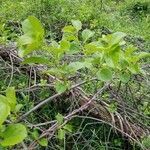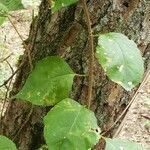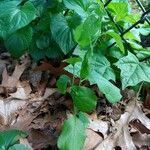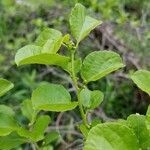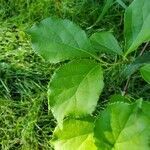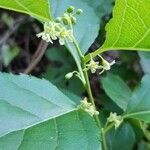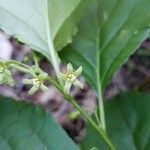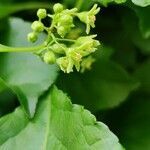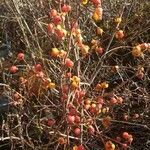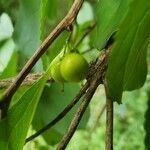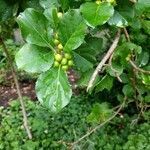Deciduous, ± glabrous climber up to 12 m high, usually dioecious or gynodioecious. Twigs green; the outermost scales of the winter buds often transformed into sharp spines 1-2 mm long. Branches terete, greyish brown. Lvs suborbicular, obovate or elliptic, obtuse to acuminate at apex, crenate, (3)-5-10 cm long. Petiole (0.5)-1-2 cm long. Cymes 1-many-flowered, shortly pedunculate, axillary. Fls c. 4-10 mm diam. Petals pale green, narrowly oblong, separated, often reduced in ♀. Capsule globose, yellow to yellow-orange, 6-8 mm diam., exposing the scarlet aril after opening.
A large vigourous climber which grows 7.5-12 m tall. The leaves are almost round and scalloped. The leaves have pointed tips. The leaves turn yellow in autumn. Male and female flowers are usually on separate plants. The flowers are small and green. The fruit are bead like and yellow. These split open to reveal scarlet coated seeds.
Vines 40+ m. Leaves: blade suborbiculate to broadly oblong-obovate or ovate-orbiculate, 4–6 × 3–5 cm, aestivation conduplicate. Inflorescences axillary, cymes, 1–2 cm. Staminate flowers: pollen white. Capsules yellow when mature, globose, 7–10 mm diam., glabrous. Seeds orange, ellipsoid, 6 mm. 2n = 46.
Much like no. 1 [Celastrus scandens L.]; lvs suborbicular to broadly oblong-obovate; fls few in small axillary cymes much shorter than the subtending lvs; 2n=46. Native of e. Asia, established as an escape in open woods and thickets here and there from Conn. s.
